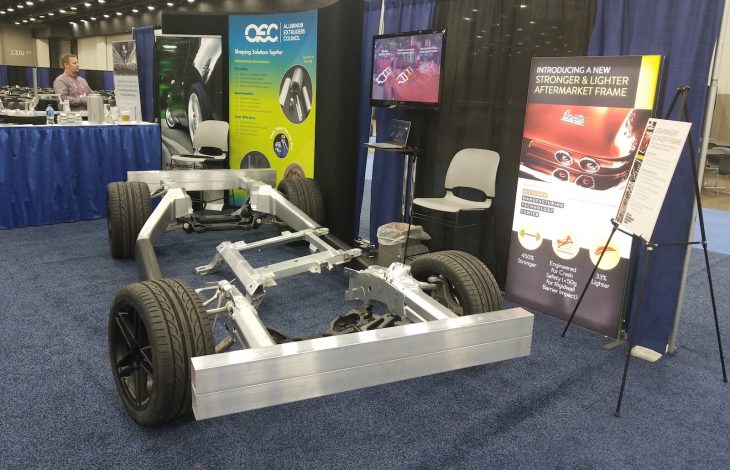The Michigan Manufacturing Technology Center unveiled an innovative lightweight aftermarket car frame at the SAE’s World Congress Experience (WCX) event in Detroit, MI. The frame was designed in response to the growing market need for alternative lightweight vehicle frame options in the custom car market. Beyond replica cars, this frame can be adapted for military applications, as a number of companies working with the Department of Defense have identified the need for a lightweight frame to be used in military vehicles to effectively lighten loads and increase fuel economy.
“Knowing there was a strong demand, we wanted to design a frame that could satisfy the needs and requirements of our customers, while incorporating innovative lightweight materials and practices,” said Elliot Forsyth, vice president of Business Operations at the Center. “The mission we have is to fundamentally solve engineering and manufacturing problems.”
The project was conceived and led by Gregg Peterson, the Center’s principal materials engineer, who was instrumental in technology transfer with NASA—successfully adapting software from the aerospace industry to automotive. A number of organizations were also involved, including: Lightweight Innovations for Tomorrow (LIFT), the University of Tennessee – Center for Industrial Services Institute for Public Service, and the Institute for Advanced Composites Manufacturing Innovation (IACMI).
Due to the wide demand for lightweight frames in the custom car market, the goal was to design a lightweight frame that could be easily morphed into virtually any wheelbase, vehicle length and width without requiring additional tooling. This ensures that the frame can be used in a variety of classic and hot rod car builds.
After considering dozens of car body frames to base the project on, the team selected the 1963-67 Corvette (C2 second generation design) due to its overall popularity around the world, being the most desirable body style among classic car aficionados. Dynamic Corvettes based in Saginaw, Michigan, assisted the team in developing specifications for the lightweight replacement frame for the C2 Corvette to ensure it was strong and safe. Detroit Engineered Products, an OEM Tier 1 design firm, produced all CAD models and performed the finite element (FE) analysis.
Two frames that shared key structural parts were developed — a short wheelbase, narrow body frame for the C2 lightweight frame and a larger frame for heavy duty military trucks. This dual use approach provided economies of scale for all end users, which helps reduce the frame cost.
Materials were selected based on the engineering team’s experience in designing lightweight structures. The frame is comprised of aluminum (33%), advanced high strength steel (29%), magnesium (13%), carbon fiber (8%), and other materials (16%) to provide the best combination of light weight and high strength for each component.
For the front and rear energy-absorbing modules, Pennex Aluminum selected the alloy, built the tooling, and supplied extrusions. “Aluminum extrusions were chosen for their energy absorbing properties, weight, and ease of adjusting section heights by combining multiple extrusions,” said Peterson. “They are easy to bond and throughbolt and simple to add internal ribbing for increased local strength.”
A challenge in the design process was the joining requirements, which included issues such as parent material degradation, sealing the mating surfaces from road contamination, nonrobotic (manual) processes, and cost effectiveness. The team chose a combination of adhesives and fasteners with inert washers. The result is a frame that offers 450% stiffer bending, 150% stiffer torsion, and a 33% lighter weight. Peterson noted that the frame “also eliminated the welding process for assembly. You don’t need a skilled welder so we can use lower-cost labor.”
A major factor in the cost consideration is assembly, which requires less than two hours for two technicians — compared to steel aftermarket frames that can exceed 40 hours for highly skilled welders using dedicated fixtures. All-steel frames must also be primed or powder-coated, adding cost and complexity to the assembly process.
In addition to reducing weight, the new frame was designed to add contemporary safety features to replica cars. Peterson explained that a crash analysis has been performed on the frame, which was “engineered to have front and rear crash zones.”

